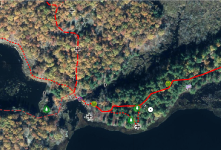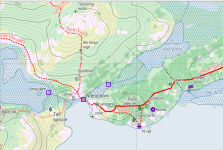Given the number of mentions in this thread, I took a look at the HuntStand app. I like what I see, with reservations. I'm not going to change, and I continue to think building one's own map using GIS software is a lot more flexible, but it's certainly a good-enough solution for many people.
I like the integration between the various tools/features it has, and it is easy to use. And I like the GPS trace functionality. That said, a few things that would be pain points for me, but might not be for many people.
1. I'm in Canada. While HuntStand does offer access to pretty detailed aerial imagery (same as Google Maps) for me, it does seem a lot of the other imagery/layers are US only. Aerial imagery varies widely in its usefulness for mapping your property. If you're sparsely vegetated, great. If you're deciduously wooded and it's early spring leaf-off imagery, also great. If you have lots of conifers, or mixed/deciduous forest imaged in mid-summer, you see very little, just canopy and open water.
2. A lot of the more useful stuff is Premium-only, like property lines and offline mapping (the latter would be crucial for me, since cell coverage on my property is poor.)
3. Premium at US$30/yr is not horribly expensive, but I am leery of having important stuff related to a long-term asset like land behind a paywall requiring yearly payment. I see they'd sell me a printed map (at a reasonable price) but not sure about data export, like a pdf?
4. The features and terminology are focused on hunting. The map annotation seems to be limited to placemarks ("map objects"), lines, and polygons, with some predefined types (e.g. boundary, food plot, sanctuary, water for polygons) and colours. Great, but constraining if you want to mark other stuff (e.g. potential trail to build later in the year, different set of placemarks than their categories.)
5. They put front and centre their commitment to conservation and hunting advocacy and what organizations they support (with your premium $). I'm not fundamentally opposed to that, but generally think it's healthier that we as individuals make our own choices. While I agree with some of what they support, one of the organizations they put front and centre I find rather off-putting. Your mileage may vary, of course.
6. As
@Complete Turf Care mentioned above, one of the Premium selling points is monthly satellite imagery, at a resolution of 1 pixel = 10 or 30 metres (30 or 100 feet). That is very useful for monitoring land use changes at your neighbours', and seasonal patterns prior to purchase (e.g., does this pond dry out or get covered in vegetation in late summer?), but it's too coarse to be useful to have in your pocket as you're walking your land. You can access this for free on your desktop at
Sentinel-hub EO-Browser3, for instance.
Anyway, a great app to try, especially in the U.S., and might fit many peoples' needs. But there are more flexible options if you actually want to create a property map *you* own and *you* customize as you see fit.

